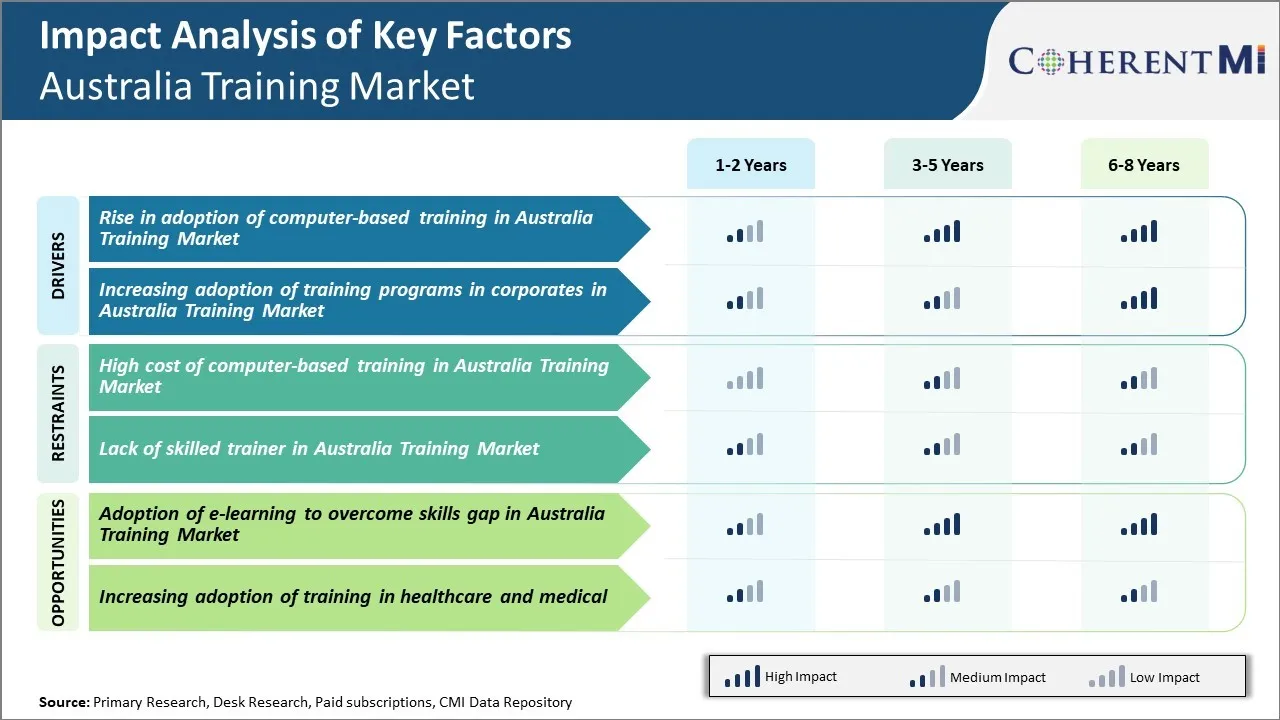Australia Training Market Trends
Market Driver – Rise in adoption of computer-based training in Australia Training Market
The Australian training landscape has seen a notable shift in recent years towards more technology-enabled and flexible learning options. As businesses and individuals alike have become increasingly tech-savvy, the demand for computer-based and online training solutions has risen sharply.
Traditional classroom-style training, while still relevant in some contexts, no longer best serves the needs of modern learners. Many professionals juggle demanding work schedules with family commitments, making it difficult to attend in-person programs that require time out of the office. Computer-based training has gained favor as it allows learning to fit around busy lifestyles. Courses can be accessed anywhere via laptop, tablet or smartphone, and paced according to the trainee's availability.
Government initiatives to boost digital skills and connectivity across Australia have supported this shift. As a result of COVID-19, there has also been accelerated adoption of online tools to support learning continuity during lockdowns and social distancing periods. This rapid change has familiarised Australians with virtual classrooms and e-learning platforms to a degree that was unimaginable just a few years ago.
Businesses have taken note of employee demand for flexible options and the potential for cost savings versus traditional training. Self-paced online modules eliminate travel expenses and lost productivity from time out of the workplace. High-quality training can now be securely delivered to staff regardless of their physical location. Vendors have responded with sophisticated learning management systems incorporating blended models of online and offline delivery.
The rise of computer-based training is set to continue as younger generations enter the workforce already comfortable with digital methods. Its benefits for work-life balance and cost-effectiveness make it a highly appealing proposition for Australian companies and learners in the years to come. While in-person programs still have value in building connections, computer-based training looks primed to dominate the training landscape.
Market Driver – Increasing adoption of training programs in corporates in Australia Training Market
As the nature of work evolves rapidly, the need for continuous skills development has never been greater for businesses. Forward-thinking companies recognise that investing in staff through ongoing training delivers both individual and organisational benefits. It drives motivation and retention by demonstrating a commitment to employees' career growth. Regular training also ensures teams have the latest technical expertise and soft skills needed to excel in their roles and tackle new challenges.
Adoption of formal training programs has grown significantly across Australian corporations of all sizes. Rather than occasional one-off events, a strategic approach involving thorough skills gap analysis and tailored multi-year plans has become the norm. Top firms schedule cohort-based programs throughout the year to maintain momentum, with topic selections informed by frequent workforce surveys and feedback.
Departmental budgets that once only accommodated mandatory compliance courses now include broader professional development allowances. Brands seeking to differentiate their employment proposition actively promote training opportunities both internally and to candidates. Subscription partnerships with multiple external providers give companies on-demand access to a rich library of courses tailored for the business environment.
Progress has been helped by the realisation that training yields tangible results. Leading firms rigorously evaluate program impact using metrics like productivity gains, error reduction, customer satisfaction scores and recurring evaluation surveys. Return on investment data strengthens the case for ongoing investment at budget planning time each year. As corporate Australia adopts more data-driven methodologies, training will maintain its role as a key performance lever into the future.

Market Challenges - High Cost of Computer-Based Training in Australia Training Market
One of the major challenges currently being faced by the Australia training market is the high cost of computer-based training programs. Developing effective e-learning courses and content requires a significant investment of time and resources from training providers. Content needs to be developed from scratch and kept up to date with the latest technologies and workforce needs. This involves hiring instructional designers, subject matter experts, multimedia developers and other professionals. Furthermore, there are ongoing costs associated with hosting the content on learning management systems, updating it regularly, and providing technical support to users. All of these factors contribute to the overall high costs of developing and delivering computer-based training programs. This cost challenge makes it difficult for some training providers, especially smaller ones, to offer extensive catalogs of online courses. It also puts pressure on course fees, potentially pricing some individuals and organizations out of the market. Unless costs can be reduced through processes like outsourcing development or leveraging open education resources, high e-learning costs may inhibit the growth and adoption of technology-driven training in Australia.
Market Opportunity – Adoption of E-Learning to Overcome Skills Gap in Australia Training Market
One opportunity for the Australia training market is boosting the adoption of e-learning to help address skills gaps. Recent research has shown there are workforce shortages in many industry sectors across technologies, healthcare and trades. E-learning provides a flexible way to reskill and upskill employees through online and blended programs they can access anywhere, anytime from mobile devices. This overcomes issues like lack of time, costs of travel and accommodation for face-to-face courses. If training providers promote the benefits of e-learning more strongly to organizations and market innovative micro credentialing solutions, it could help reskill many existing workers from home or work environments. Greater use of online simulations and virtual reality could also engage learners in experiential skills development. With skills shortages a pressing issue, promoting adoption of technology-driven e-learning stands to benefit both training providers and industries across Australia in need of qualified talent.